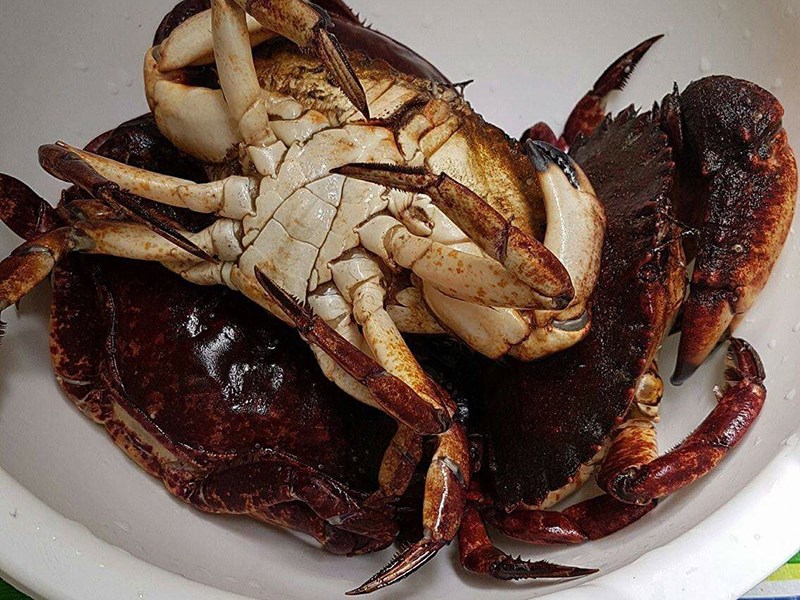While the majority of people fishing for crabs follow the rules, there are a few who are not following regulations, according to the Department of Fisheries and Oceans (DFO).
“Illegal activity is the exception, not the rule,” said DFO field supervisor Ben Rahier.
While there may not be statistics on how prevalent poaching is on the coast, Powell River resident and Vancouver Police Department detective Jordan Lennox said that he recently came face to face with poaching at Willingdon Beach.
“I know that it’s been a bit of a problem up here,” said Lennox.
Lennox, who grew up in Powell River, said he is aware of bus trips from the Lower Mainland arriving at Okeover Inlet and Myrtle Rocks to harvest seafood off the beach, but he was surprised to see illegal crabbing off the pier in Powell River’s most popular park.
It was about 11 pm one night a few weeks ago that he saw a man carrying a large container followed by three women holding crab traps. He went down to the pier to investigate and found that they had left one trap down. He pulled it up and found it was illegal, modified and not marked with a name or phone number.
“So I seized it and brought it up to fisheries,” said Lennox. “I know it’s not the crime of the century, but I shared the experience with a few people and they were appalled.”
Lennox said he thinks that the practice of people coming up from the Lower Mainland to poach crabs and other seafood is incredibly common.
“They can’t do it down there anymore because it’s all been ruined, so that’s why they’re coming up here,” he said.
For Tla’amin Nation resident Erik Blaney, the experience of encountering poachers is something that he wishes happened more infrequently.
“Unfortunately, it’s a common occurrence,” said Blaney. “There are lots of different people coming up. It’s frustrating, but we do what we can.”
For six years, Blaney worked for Tla’amin Nation compliance and enforcement and monitored area beaches.
“Over those years we documented quite a number of people from out of town coming in and pillaging the beaches pretty hard,” he said.
Blaney, who has worked with BC Parks, said that one current problem is that there are too few park rangers and conservation officers over too much area.
“People in the community are at a loss of what to do,” he said. “You observe, record and report the best you can, but by the time an officer comes they are sometimes two days away. Often, it’s all for nothing.”
He added that the budget cutbacks of 2008 hit the BC Ministry of Environment pretty hard, BC Parks had to sell their monitoring vessel and there was not a park ranger in Powell River for two years.
In Tla’amin, Blaney said that some people are going out of their way to ask people to show their tidal-water licences.
“It’s just tough when 30 people show up and they all have a permit and five-gallon pails. They are taking a lot of seafood off of the beach,” said Blaney. “Even they’re saying there’s no more shellfish on the beach anymore.”
According to federal fisheries regulations, one person is allowed to take a total of 75 clams and four crabs.
Size of the crabs is also an issue, said Rahier. He said that taking female crabs is not permitted, but making sure that male crabs are of the right size is important because it will mean that they have had at least one opportunity to spawn before they reach legal size.
Rahier said that recreational crab traps have to be marked with identification and also be equipped with rot cord.
Rot cord, or biodegradable twine, holds an escape hatch on the trap secure, but if the trap is lost then the twine will rot and stop the trap from ghost fishing if it is lost, said Rahier.
“You could probably talk to 100 recreational fishers and probably 40 per cent would not even know why you’re supposed to use rot cord,” said Rahier. “Lack of education is probably a factor, as well as folks not labelling their traps.”
Rahier said he had noted that compliance to regulation is pretty high in Powell River, but locally fisheries officers still collect upwards of 30 illegal traps each year.
The effects of over-harvesting are also being felt on Savary Island. Savary resident Paul Leighton said the island community is becoming more aware and watchful of what is happening on island beaches. He said the clam beds on First Beach were picked clean last year.
“I see this as an education and an enforcement thing, but of course neither of those things exist,” said Leighton.
He added that on the north side of the island there used to be a big intertidal zone that teamed with sea life, but pollution and over-harvesting have taken a toll.



